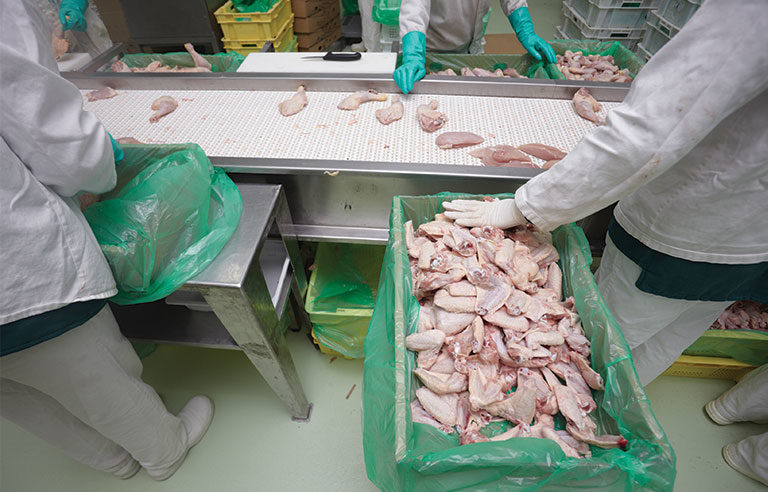USDA: Faster meat-processing line speeds contribute to worker MSDs

Washington — Increased line speeds in poultry- and pork-processing plants aren’t the “leading factor in worker musculoskeletal disorder risk” but combine with other factors to contribute to employees’ overall risk, the U.S. Department of Agriculture says.
USDA’s Food Safety Inspection Service recently completed a pair of studies that examined the effects of increased line speeds on worker safety.
FSIS announced its study of poultry-processing plants in July 2022, stating the research would inform future rulemaking related to line speed waivers issued under the agency’s New Poultry Inspection System. Participating facilities received a modified waiver permitting their line speeds to increase to 175 birds per minute from the current 140.
The agency initiated a similar study for pork-processing facilities in November of that same year. Certain plants took part in a trial to operate at speeds exceeding the current maximum line speed of 1,106 hogs an hour.
For each study, a group of third-party worker safety experts conducted interviews and site analyses, as well as recorded processing-line workers on the job. They measured muscle activity, posture, repetitive motions and other behaviors while comparing the risk of upper-extremity pain and MSDs for workers operating at higher and lower speeds.
The researchers found that 81% of poultry-processing workers and 46% of pork-processing workers faced an increased MSD risk. About 2 out of 5 workers reported they had experienced moderate to severe work-related upper extremity pain in the previous year.
The studies also revealed that piece rate – the number of meat parts a worker handles per minute – was associated with a greater MSD risk. In the poultry study, plants operating at higher line speeds had piece rates comparable to those operating at lower speeds.
Included in the studies are FSIS recommendations for line-processing employers and workers:
- Increase staffing to mitigate the impact of repetitive work
- Improve medical management programs that assess ongoing pain as a metric of exposure to ergonomic risk
- Promote a safety culture that encourages reporting of pain and discourages retaliation or consequences for reporting
- Apply best practices to knife and scissor sharpening, maintenance and replacement, provision of new knives at shift start, routine replacement of knives multiple times during shifts, etc.
- Fully implement industry-specific best practice guidelines previously published by OSHA
Additionally, FSIS announced it has extended to May 15 the poultry-processing waiver and pork-processing trials for the plants that participated in the studies. Both were set to expire Jan. 15.
The National Chicken Council, a poultry industry representative and advocate of unrestricted line speeds, maintains that operating at speeds of up to 175 birds per minute is a long-standing and safe industry practice. NCC officials want USDA to make the line-speed increase permanent.
NCC officials cite data on nonfatal injuries and illnesses among workers in the private sector, released in November by the Bureau of Labor Statistics, that shows the poultry industry’s decreasing rate of nonfatal injuries – 2.6 per 100 full-time equivalent workers. NCC claims the 2023 rate was below that for similar agricultural industries (4.7) and food manufacturing (3.6). Further, the organization contends that the rate has fallen 89% since 1994, when it stood at 22.7.
“Although we have seen a substantial reduction in injury and illness rates, the industry remains committed to continuous improvement and exploring innovative approaches to further protect our workforce,” Ashley Peterson, senior vice president of scientific and regulatory affairs at NCC, said in a press release. “While many of the recommendations in the report are already included in our current worker safety programs, we take the recommendations seriously and will use the information to bolster our existing programs as appropriate.”
In a separate release, acting Labor Secretary Julie Su said: “The study found that the increased risk of injuries created by increasing line speeds could be mitigated with other controls, specifically having more workers on the line and having effective ergonomic plans. I hope that meat and poultry companies do what is needed to make worker safety a first principle. The health of our nation depends on it.”
Post a comment to this article
Safety+Health welcomes comments that promote respectful dialogue. Please stay on topic. Comments that contain personal attacks, profanity or abusive language – or those aggressively promoting products or services – will be removed. We reserve the right to determine which comments violate our comment policy. (Anonymous comments are welcome; merely skip the “name” field in the comment box. An email address is required but will not be included with your comment.)

